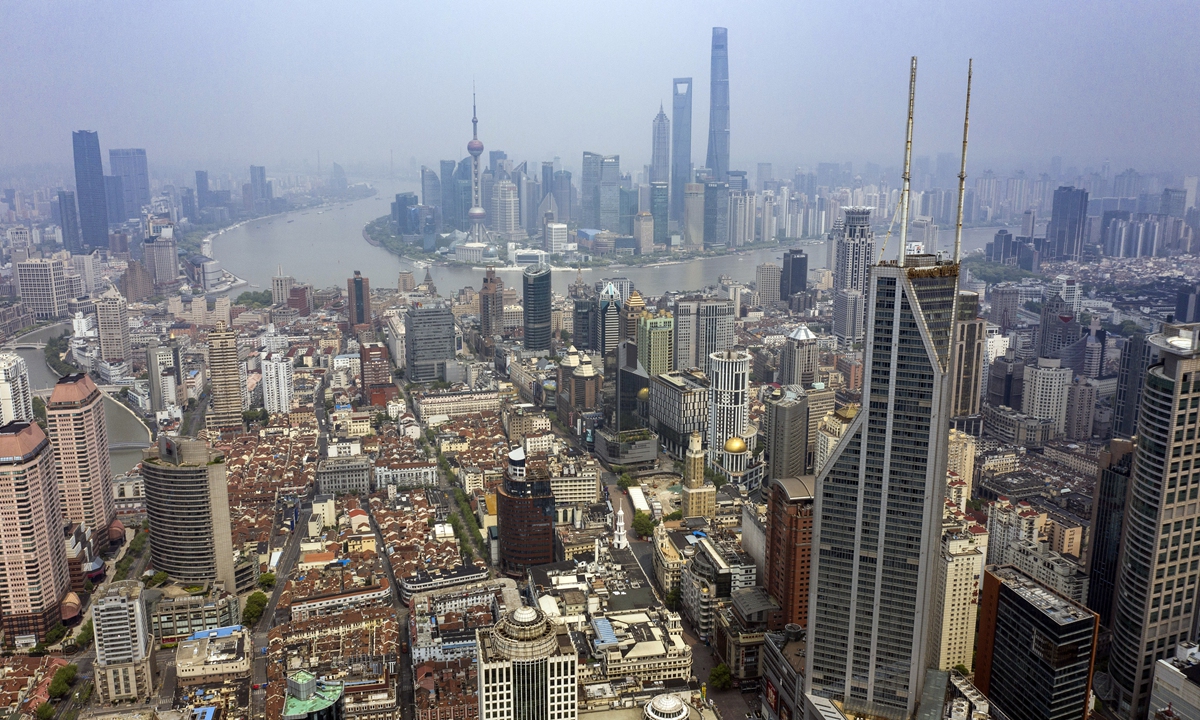
Shanghai streets are nearly deserted on April 19, 2022, as the megacity remains under strict epidemic control management except for the partial resumption in production of certain industries. Photo: VCG
Shanghai reported 3.1 percent GDP growth in the first quarter of the year, a sharp decline from 17.6 percent last year, and also slower than the country's average of 4.8 percent as the coronavirus impact exerted pressure on the financial hub, and a leading growth engine of the world's second-largest economy, starting March.
In the first quarter, the city's GDP reached one trillion yuan ($153.96 billion), up by 3.1 percent over the same period last year. The growth represents 1.6 percentage points lower than the past two-year average, indicating greater downward pressure amid the epidemic.
Experts also warned of "greater downward pressure" starting April, when the city enters a stricter lockdown in an effort to curb surging Omicron cases faster, noting that only a rapid containment of the virus can the economic activities be restored to full capacity.
The slowdown was mainly due to the impact of a sudden epidemic outbreak in March, affecting the steady growth of the city's economy in the first quarter, while the overall economic and social situation remained stable on the whole, the Shanghai statistics bureau said on Saturday.
Some major economic indicators all weakened in the first quarter. For instance, the added value of industrial enterprises above a designated size increased by 3.9 percent year-on-year, 8.0 percentage points lower than in the first two months. Total retail sales of consumer goods dropped 3.8 percent, reversing the 3.7 percent growth in the first two months.
Foreign trade increased 14.6 percent, 7.4 percentage points lower than in January and February, official data showed.
The epidemic in March had a greater impact on GDP in the first quarter, since March should have been an important time for resuming work, production and consumption after the Spring Festival, Cong Yi, professor of the Tianjin University of Finance and Economics, told the Global Times on Saturday.
Cong said the financial hub could have achieved a 6-7 percent growth in the first quarter if not for the virus.
The expert further noted that the GDP growth trend in the second quarter is "not optimistic," and still depends on whether the epidemic can be effectively controlled in the short term, calling for more efforts to push for work resumption.
Shanghai's battle against COVID-19 has entered a key phase of stamping out viral infections within residential communities, the Shanghai authority told media on Friday. Officials said the lockdown would be lifted in batches when virus transmissions outside quarantined areas are eliminated. A new round of testing has also been announced specifically for different districts.
Meanwhile, local authorities have also ramped up business resumption in the past week amid strict epidemic controls, announcing a slew of guidelines and policies to help key enterprises call back stranded staff, and unblock logistics bottlenecks.
"If the virus can see an inflection point in the two weeks, we can expect a recovery in May or June," Cong said, noting that the city will also see a rapid rebound once the epidemic in Shanghai is under control, given Shanghai's economic vitality and its critical role in the country.
On the bright side, which indicates resilience of the financial hub, the city's financial market turnover totaled 648.01 trillion yuan in the first quarter, an increase of 14.7 percent over the same period last year. Among them, marketable securities and inter-bank market turnover of the Shanghai Stock Exchange increased by 19.5 percent and 20.5 percent, respectively.
As an international shipping hub, Shanghai's international standard container throughput was 12.26 million TEUs in the first quarter, a year-on-year increase of 8.1 percent. In late March, the average daily container throughput of the Shanghai Port was about 140,000 TEUs, maintaining a high level of operations.
Foreign direct investment also showed steady growth. Fifteen new regional headquarters of multinational companies and six foreign R&D centers were established in the first quarter.




